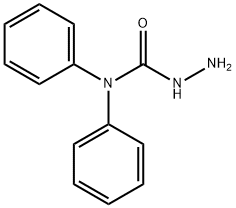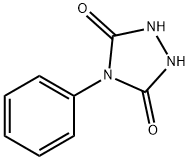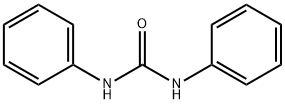Phenylurea
Synonym(s):Phenylcarbamide
- CAS NO.:64-10-8
- Empirical Formula: C7H8N2O
- Molecular Weight: 136.15
- MDL number: MFCD00007944
- EINECS: 200-576-5
- SAFETY DATA SHEET (SDS)
- Update Date: 2024-12-18 14:07:02

What is Phenylurea?
Chemical properties
Colorless needle-like crystals or off-white powder. Melting point 147°C(decomposition), soluble in hot water, hot alcohol, ether, ethyl acetate and acetic acid.
The Uses of Phenylurea
Phenyl urea is used in organic synthesis. It acts as an efficient ligand for palladium-catalyzed Heck and Suzuki reactions of aryl bromides and iodides.
The Uses of Phenylurea
Phenylureas are commonly used soil-applied herbicides for control of grass and small-seeded broadleaf weeds.
What are the applications of Application
N-Phenylurea is a building block
Preparation
Phenylurea is synthesized by the reaction of aniline and urea. Put urea, hydrochloric acid and aniline into the reaction pot, heat and stir, reflux at 100-104°C for 1 hour, add water and stir, cool, filter, wash the filter cake with water, and dry to obtain the finished product of phenylurea.
What are the applications of Application
Phenyl urea pesticide, liquid, poisonous appears as a liquid dissolved or suspended in a liquid carrier. Contains any of several related compounds (Diuron, Fenuron, Linuron, Neburon, Siduron, Monuron) formally derived from urea. Carrier is water emulsifiable. Toxic by inhalation, skin absorption, or ingestion.
Definition
ChEBI: 1-Phenylurea is a member of ureas.
General Description
A solid or liquid absorbed on a dry carrier. A wettable powder. Contains any of several related products (Diuron, Fenuron, Linuron, Monuron, Neburon, Siduron) formally derived from urea. Toxic by inhalation, skin absorption, or ingestion. Obtain the technical name of the specific pesticide from the shipping papers and contact CHEMTREC, 800-424-9300 for response information.
Reactivity Profile
Organic amides/imides react with azo and diazo compounds to generate toxic gases. Flammable gases are formed by the reaction of organic amides/imides with strong reducing agents. Amides are very weak bases (weaker than water). Imides are less basic yet and in fact react with strong bases to form salts. That is, they can react as acids. Mixing amides with dehydrating agents such as P2O5 or SOCl2 generates the corresponding nitrile. The combustion of these compounds generates mixed oxides of nitrogen (NOx). Contains any of several related compounds (Diuron, Fenuron, Linuron, Neburon, Siduron, Monuron) formally derived from urea.
Health Hazard
Highly toxic, may be fatal if inhaled, swallowed or absorbed through skin. Avoid any skin contact. Effects of contact or inhalation may be delayed. Fire may produce irritating, corrosive and/or toxic gases. Runoff from fire control or dilution water may be corrosive and/or toxic and cause pollution.
Fire Hazard
Non-combustible, substance itself does not burn but may decompose upon heating to produce corrosive and/or toxic fumes. Containers may explode when heated. Runoff may pollute waterways.
Purification Methods
Crystallise the urea from boiling water (10mL/g) or amyl alcohol (m 149o). Dry it in a steam oven at 100o. The 1:1 resorcinol complex has m 115o (from EtOAc/*C6H6). [Beilstein 12 H 346, 12 II 204, 12 III 760, 12 IV 734.]
Properties of Phenylurea
| Melting point: | 145-147 °C(lit.) |
| Boiling point: | 238 °C |
| Density | 1,302 g/cm3 |
| vapor density | >1 (vs air) |
| refractive index | 1.5769 (estimate) |
| Flash point: | 238°C |
| storage temp. | Keep in dark place,Sealed in dry,Room Temperature |
| solubility | H2O: 10 mg/mL, clear |
| pka | 13.37±0.50(Predicted) |
| form | Powder, Crystals and/or Chunks |
| color | White to light yellow |
| Water Solubility | Soluble in water. |
| Merck | 14,7319 |
| BRN | 1934615 |
| Stability: | Stable. Incompatible with strong oxidizing agents. |
| CAS DataBase Reference | 64-10-8(CAS DataBase Reference) |
| EPA Substance Registry System | Urea, phenyl- (64-10-8) |
Safety information for Phenylurea
| Signal word | Warning |
| Pictogram(s) |
 Exclamation Mark Irritant GHS07 |
| GHS Hazard Statements |
H302:Acute toxicity,oral H315:Skin corrosion/irritation H319:Serious eye damage/eye irritation |
| Precautionary Statement Codes |
P264:Wash hands thoroughly after handling. P264:Wash skin thouroughly after handling. P270:Do not eat, drink or smoke when using this product. P280:Wear protective gloves/protective clothing/eye protection/face protection. P330:Rinse mouth. P501:Dispose of contents/container to..… |
Computed Descriptors for Phenylurea
| InChIKey | LUBJCRLGQSPQNN-UHFFFAOYSA-N |
New Products
Tert-butyl bis(2-chloroethyl)carbamate (S)-3-Aminobutanenitrile hydrochloride N-Boc-D-alaninol N-BOC-D/L-ALANINOL N-octanoyl benzotriazole 4-Hydrazinobenzoic acid 3,4-Dibenzyloxybenzaldehyde 1,1’-CARBONYLDIIMIDAZOLE R-2-BENZYLOXY PROPIONIC ACID 1,1’-CARBONYLDI (1,2-4 TRIAZOLE) 4-HYDROXY BENZYL ALCOHOL 3-NITRO-2-METHYL ANILINE (2-Hydroxyphenyl)acetonitrile 4-Bromopyrazole 5-BROMO-2CYANO PYRIDINE 5,6-Dimethoxyindanone 5-broMo-2-chloro-N-cyclopentylpyriMidin-4-aMine 4-methoxy-3,5-dinitropyridine 2-(Cyanocyclohexyl)acetic acid 2-aminopropyl benzoate hydrochloride 1-(4-(aminomethyl)benzyl)urea hydrochloride tert-butyl 4- (ureidomethyl)benzylcarbamate diethyl 2-(2-((tertbutoxycarbonyl)amino) ethyl)malonate Ethyl-2-chloro((4-methoxyphenyl)hydrazono)acetateRelated products of tetrahydrofuran








You may like
-
 Phenylurea CAS 64-10-8View Details
Phenylurea CAS 64-10-8View Details
64-10-8 -
 Phenylurea >98% (HPLC) CAS 64-10-8View Details
Phenylurea >98% (HPLC) CAS 64-10-8View Details
64-10-8 -
 Phenylurea CAS 64-10-8View Details
Phenylurea CAS 64-10-8View Details
64-10-8 -
 Phenylurea 95% CAS 64-10-8View Details
Phenylurea 95% CAS 64-10-8View Details
64-10-8 -
 N-Phenylurea CAS 64-10-8View Details
N-Phenylurea CAS 64-10-8View Details
64-10-8 -
 N-Vinylformamide 99%View Details
N-Vinylformamide 99%View Details
13162-05-5 -
 2-ethyl-6-methyl-3-hydroxypyridine succinate 99%View Details
2-ethyl-6-methyl-3-hydroxypyridine succinate 99%View Details
127464-43-1 -
 2-ETHYLPYRIDINE 100-71-0 99%View Details
2-ETHYLPYRIDINE 100-71-0 99%View Details
100-71-0